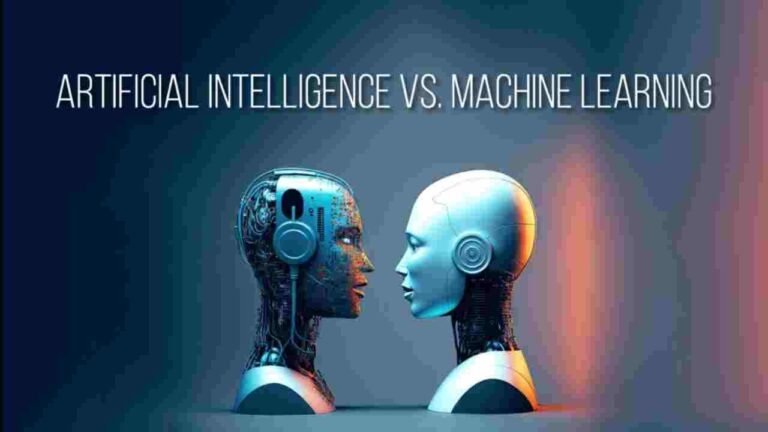1. What Is Artificial Intelligence (AI)?
Artificial Intelligence (AI) is a broad field of computer science focused on creating systems capable of performing tasks that normally require human intelligence. These tasks include problem-solving, reasoning, learning, natural language understanding, and decision-making. AI can be applied across industries to enhance automation, improve efficiency, and enable predictive analytics.
Key Features:
- Simulates human intelligence and decision-making
- Can perform complex tasks like speech recognition and image analysis
- Broad applications across multiple industries
2. What Is Machine Learning (ML)?
Machine Learning is a subset of AI that focuses on training algorithms to learn patterns from data and make predictions or decisions without explicit programming. ML algorithms improve performance over time by analyzing historical data and adapting to new information.
Key Features:
- Learns patterns from large datasets
- Improves automatically with experience
- Enables predictive analytics and automation
3. Key Differences Between AI and Machine Learning
Understanding the distinction between AI and ML is critical:
| Feature | Artificial Intelligence (AI) | Machine Learning (ML) |
|---|---|---|
| Definition | Broad field to simulate human intelligence | Subset of AI focused on learning from data |
| Approach | Rules-based, logic, reasoning | Data-driven, pattern recognition |
| Goal | Perform intelligent tasks | Learn and improve from data |
| Applications | Robotics, expert systems, chatbots | Predictive analytics, recommendation systems |
| Dependency | Can work with or without data | Requires large datasets for training |
4. Applications of AI
AI has widespread applications across industries:
- Healthcare: Diagnosis, predictive health analytics, robotic surgery
- Finance: Fraud detection, algorithmic trading, customer service bots
- Retail: Customer behavior prediction, inventory management
- Transportation: Autonomous vehicles, traffic optimization
Key Features:
- Automates complex tasks
- Provides insights for decision-making
- Enhances productivity across sectors
5. Applications of Machine Learning
ML is used to analyze data, detect patterns, and make predictions:
- E-commerce: Personalized recommendations for products
- Marketing: Customer segmentation and predictive analytics
- Healthcare: Disease prediction and drug discovery
- Cybersecurity: Threat detection and anomaly detection
Key Features:
- Learns from historical data
- Enables predictive modeling
- Supports personalized and automated solutions
6. How AI and ML Work Together
AI and ML are closely linked. Machine learning provides the data-driven foundation that enables AI systems to make intelligent decisions. For instance, AI-powered chatbots use ML algorithms to understand customer queries and improve responses over time, combining reasoning and learning for better performance.
Key Features:
- ML feeds AI with data insights
- AI applies learned patterns for decision-making
- Collaborative improvement of automated systems
7. Benefits of AI and ML for Businesses
- Efficiency: Automates repetitive tasks and processes
- Accuracy: Reduces errors and enhances decision-making
- Innovation: Enables new products, services, and business models
- Customer Experience: Personalizes interactions and services
Key Features:
- Optimizes operational workflows
- Supports data-driven business strategies
- Enhances competitive advantage
8. Challenges and Considerations
- Data Quality: ML depends on high-quality, large datasets
- Cost: Implementing AI/ML solutions requires investment
- Bias: Poorly trained models may produce biased outcomes
- Complexity: Requires skilled professionals for development and maintenance
Key Features:
- Ensures accurate predictions with quality data
- Requires technical expertise and resources
- Needs continuous monitoring for fairness and effectiveness
Conclusion
AI and Machine Learning are transforming industries by enabling automation, predictive analytics, and intelligent decision-making. While AI is the broader concept of simulating human intelligence, ML is its subset that allows systems to learn from data. Together, they empower businesses to innovate, improve efficiency, and enhance customer experiences. Understanding their differences and applications is essential for leveraging these technologies effectively.

